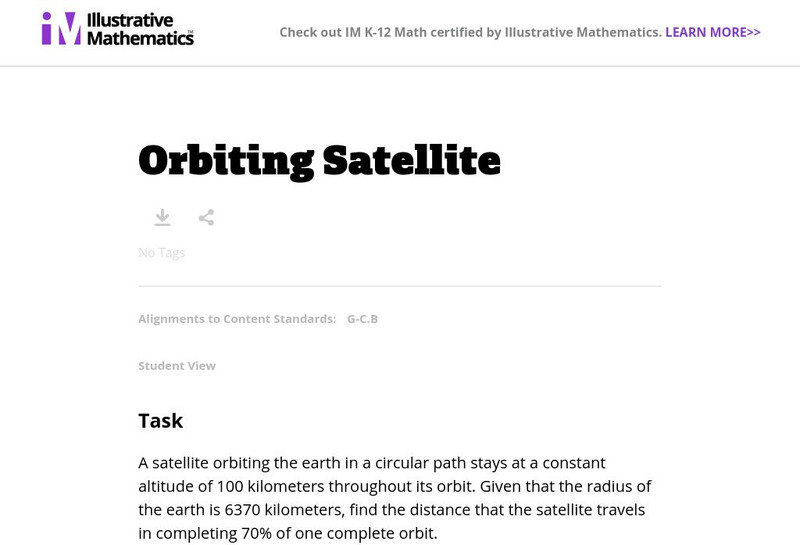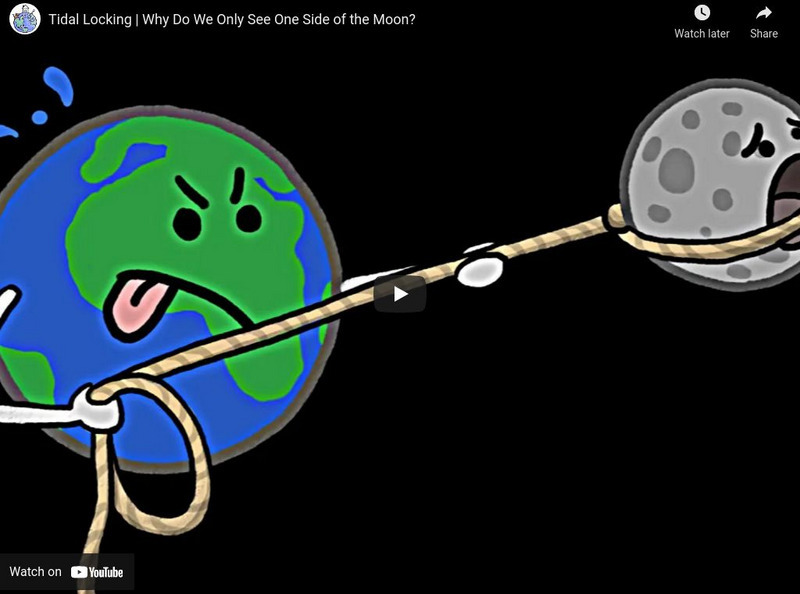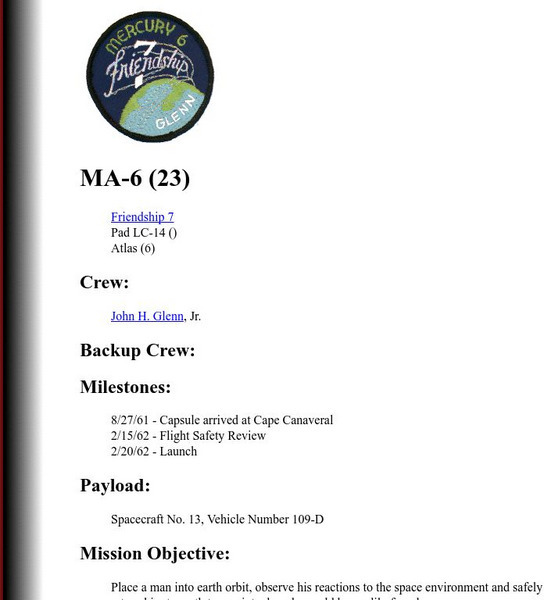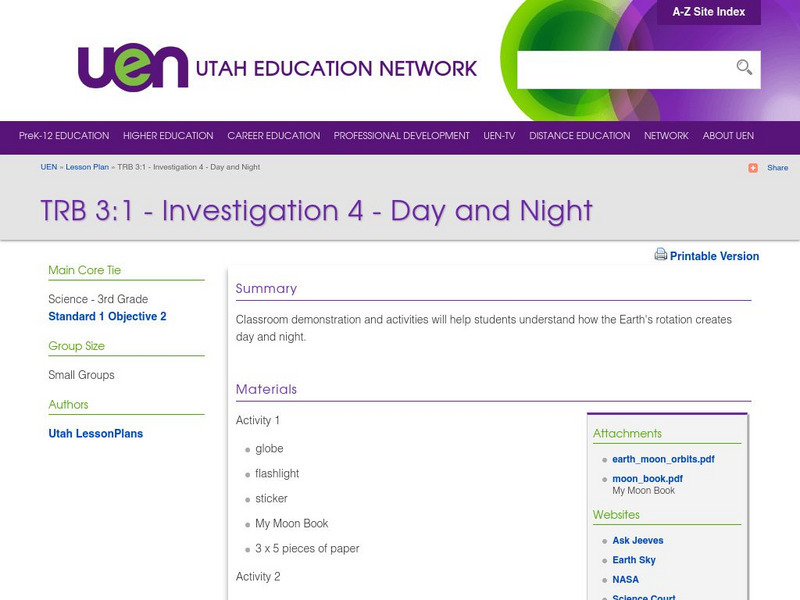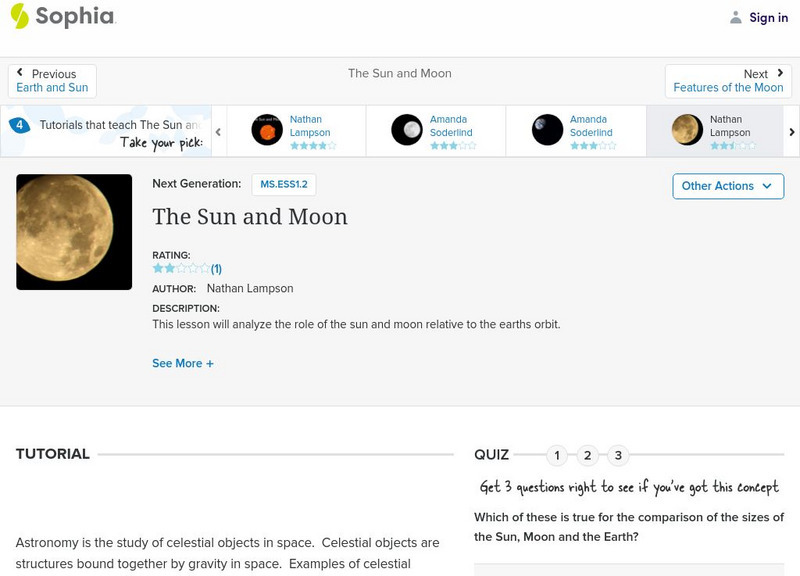Earth's Orbit Teacher Resources
Find Earth's Orbit lesson plans and worksheets
Showing 1,060 resources
Crash Course
Crash Course Kids 22.2: Orbits Are Odd
Why doesn't the moon just crash into the Earth? And why doesn't the Earth crash into the Sun? What are orbits exactly and why do they happen? Well, it has to do with gravity and velocity. In this episode of Crash Course Kids, Sabrina...
NOAA
Noaa: Satellites in Orbit [Pdf]
Construct a model that helps to show how satellites stay in orbit around the Earth. Then see how a flashlight can help explain how a satellite can send messages to different locations.
Harvard University
Harvard University: Eyes on the Sky, Feet on the Ground: The Earth's Moon
In this online textbook, students explore the phases of the moon, the moon's orbit, the origin of the moon, and the tides. Includes numerous inquiry-based activities.
Illustrative Mathematics
Illustrative Mathematics: G C Orbiting Satellite
A satellite is orbiting the Earth at a given height and students are asked to find the distance it travels to complete 70 percent of an orbit. This task provides a context for connecting an angle in radians to the arc length intercepted...
PBS
Pbs News Hour Extra: Satellites Orbit the Sun to Better Predict Solar Storms
For the first time, NASA scientists have generated a full image of the sun, front and back, using twin orbiting satellites. The new view of Earth's star will allow for the study of solar weather events like coronal mass ejections that...
NASA
Nasa: Visible Earth: 3 D Data From Ice Sat
3-D Data from ICESat: Orbiting the Earth at nearly 17,000 miles per hour, NASA's Ice, Cloud and land Elevation Satellite (ICESat) is collecting spectacular new three-dimensional measurements of the Earth's surface and atmosphere.
Khan Academy
Khan Academy: What Causes Precession and Other Orbital Changes
Video lecture explores what causes precession and other orbital changes. [2:26]
Project Britain
Primary Homework Help: Earth and Space Quiz
This resource provides information about Earth and space. In addition, there is a quiz provided.
Other
Astro Methods: Earth's Nutation Visualized
Nutation is a small cyclical motion superimposed upon the steady 26,000-year precession of the Earth's axis of rotation. It is mainly caused by the gravitational effect of the 18.6-year rotation period of the Moon's orbit. The main...
Khan Academy
Khan Academy: Newton's Law of Gravitation: Gravity for Astronauts in Orbit
Video lecture explains why astronauts appear weightless despite being near the Earth. [7:12]
Minute Earth
Minute Earth: Tidal Locking/why Do We Only See One Side of the Moon?
The following video provides a brief explanation as to why we only see one side of the moon from planet Earth. [2:27]
E-learning for Kids
E Learning for Kids: Egypt: How Do the Sun, Moon and Earth Revolve Around Each Other?
Omar helps his parents sell things at the market. Join him while he learns about the relationship of the Sun, Moon, and Earth.
Utah Education Network
Uen: As the World Turns
Third graders use their bodies to act out the motions of earth.
Harvard University
Harvard University: Eye on the Sky, Feet on the Ground
An ebook filled with information and classroom activities covering several astrological topics such as the Earth's rotation and the solar system. Many tips and teaching tools are available to aid in discovering what the sky has to offer.
American Geosciences Institute
American Geosciences Institute: Astronomy
Eight hands-on lessons module in which students explore the characteristics of planet Earth, its moons, the sun, the solar system, planets, and the difference between science fact and science fiction.
Massachusetts Institute of Technology
Mit: Open Course Ware: Earth, Atmospheric and Planetary Sciences: Solar System
A university-level course that looks at the structure of the solar system, the sun, the planets, and other bodies in space. Includes course readings, assignments, and study notes.
Utah Education Network
Uen: Trb 3:1: Investigation 4: Day and Night
A lesson for third graders in which they learn about the rotation of the Earth on its axis and how this movement creates day and night. They also examine the orbit of the moon about the Earth and the Earth's orbit around the sun.
Sophia Learning
Sophia: The Sun and Moon: Lesson 2
This lesson will analyze the role of the sun and moon relative to the earth's orbit. It is 2 of 4 in the series titled "The Sun and Moon."
Sophia Learning
Sophia: The Sun and Moon: Lesson 3
This lesson will analyze the role of the sun and moon relative to the earth's orbit. It is 3 of 4 in the series titled "The Sun and Moon."
Sophia Learning
Sophia: The Sun and Moon: Lesson 4
This lesson will analyze the role of the sun and moon relative to the earth's orbit. It is 4 of 4 in the series titled "The Sun and Moon."
NASA
Nasa: John Glenn the Hero
This site from NASA provides a detailed description of events following the successful 3 Earth orbit mission of the Friendship 7 Mercury spacecraft.
PBS
Pbs Learning Media: Crash Course Astronomy: Cycles in the Sky
Take a look at the cyclical phenomena at work in the universe. Learn about the subtle changes in the sky that take place over time as the Earth circles the sun, following along the ecliptic. Learn how the tilt of the Earth's axis has a...
Curated OER
Harvard University: The Earths Orbit
Students perform many inquiry activities related to Earth's orbit. Included are recording daily temperatures, observing the sun's path over several weeks, tracking sunrise and sunset times, and angle of sunlight. Diagrams make lessons...
Other popular searches
- Earth Orbit the Sun
- Earth Orbit Sun
- Earth Orbit Seasons
- Moon Earth Orbit
- Gravity Moon Earth Orbit
- Earth Orbit Rotation
- Low Earth Orbit Satellites
- Low Earth Orbit
- Moon Earth Orbit Lesson
- Earth Orbit Tilt
- Orbit of Earth
- Earth Orbiting the Sun



![Noaa: Satellites in Orbit [Pdf] Activity Noaa: Satellites in Orbit [Pdf] Activity](https://d15y2dacu3jp90.cloudfront.net/images/attachment_defaults/resource/large/FPO-knovation.png)

